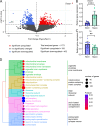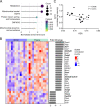Normobaric hypoxia shows enhanced FOXO1 signaling in obese mouse gastrocnemius muscle linked to metabolism and muscle structure and neuromuscular innervation
- PMID: 37656229
- PMCID: PMC10567817
- DOI: 10.1007/s00424-023-02854-4
Normobaric hypoxia shows enhanced FOXO1 signaling in obese mouse gastrocnemius muscle linked to metabolism and muscle structure and neuromuscular innervation
Abstract
Skeletal muscle relies on mitochondria for sustainable ATP production, which may be impacted by reduced oxygen availability (hypoxia). Compared with long-term hypoxia, the mechanistic in vivo response to acute hypoxia remains elusive. Therefore, we aimed to provide an integrated description of the Musculus gastrocnemius response to acute hypoxia. Fasted male C57BL/6JOlaHsd mice, fed a 40en% fat diet for six weeks, were exposed to 12% O2 normobaric hypoxia or normoxia (20.9% O2) for six hours (n = 12 per group). Whole-body energy metabolism and the transcriptome response of the M. gastrocnemius were analyzed and confirmed by acylcarnitine determination and Q-PCR. At the whole-body level, six hours of hypoxia reduced energy expenditure, increased blood glucose and tended to decreased the respiratory exchange ratio (RER). Whole-genome transcriptome analysis revealed upregulation of forkhead box-O (FOXO) signalling, including an increased expression of tribbles pseudokinase 3 (Trib3). Trib3 positively correlated with blood glucose levels. Upregulated carnitine palmitoyltransferase 1A negatively correlated with the RER, but the significantly increased in tissue C14-1, C16-0 and C18-1 acylcarnitines supported that β-oxidation was not regulated. The hypoxia-induced FOXO activation could also be connected to altered gene expression related to fiber-type switching, extracellular matrix remodeling, muscle differentiation and neuromuscular junction denervation. Our results suggest that a six-hour exposure of obese mice to 12% O2 normobaric hypoxia impacts M. gastrocnemius via FOXO1, initiating alterations that may contribute to muscle remodeling of which denervation is novel and warrants further investigation. The findings support an early role of hypoxia in tissue alterations in hypoxia-associated conditions such as aging and obesity.
Keywords: FOXO; Hypoxia; Metabolism; Mitochondria; Neuromuscular junction; Skeletal muscle.
© 2023. The Author(s).
Conflict of interest statement
The authors declare no competing interests.
Figures





Similar articles
-
Six-hour hypoxia-induced protein degradation in M. gastrocnemius of 24-day-old mice by activating FOXO1 and suppressing AKT-mTORC1.Am J Physiol Endocrinol Metab. 2025 Apr 1;328(4):E620-E632. doi: 10.1152/ajpendo.00508.2024. Epub 2025 Mar 17. Am J Physiol Endocrinol Metab. 2025. PMID: 40094441
-
Effect of chronic intermittent hypoxia (CIH) on neuromuscular junctions and mitochondria in slow- and fast-twitch skeletal muscles of mice-the role of iNOS.Skelet Muscle. 2022 Feb 12;12(1):6. doi: 10.1186/s13395-022-00288-7. Skelet Muscle. 2022. PMID: 35151349 Free PMC article.
-
Metabolic physiology and skeletal muscle phenotypes in male and female myoglobin knockout mice.Am J Physiol Endocrinol Metab. 2021 Jul 1;321(1):E63-E79. doi: 10.1152/ajpendo.00624.2020. Epub 2021 May 10. Am J Physiol Endocrinol Metab. 2021. PMID: 33969704 Free PMC article.
-
The impact of altered carnitine availability on acylcarnitine metabolism, energy expenditure and glucose tolerance in diet-induced obese mice.Biochim Biophys Acta. 2016 Aug;1862(8):1375-82. doi: 10.1016/j.bbadis.2016.04.012. Epub 2016 Apr 22. Biochim Biophys Acta. 2016. PMID: 27112275
-
Remodeling of skeletal muscle mitochondrial proteome with high-fat diet involves greater changes to β-oxidation than electron transfer proteins in mice.Am J Physiol Endocrinol Metab. 2018 Oct 1;315(4):E425-E434. doi: 10.1152/ajpendo.00051.2018. Epub 2018 May 29. Am J Physiol Endocrinol Metab. 2018. PMID: 29812987 Free PMC article.
References
Grants and funding
LinkOut - more resources
Full Text Sources
Molecular Biology Databases
Research Materials
Miscellaneous

